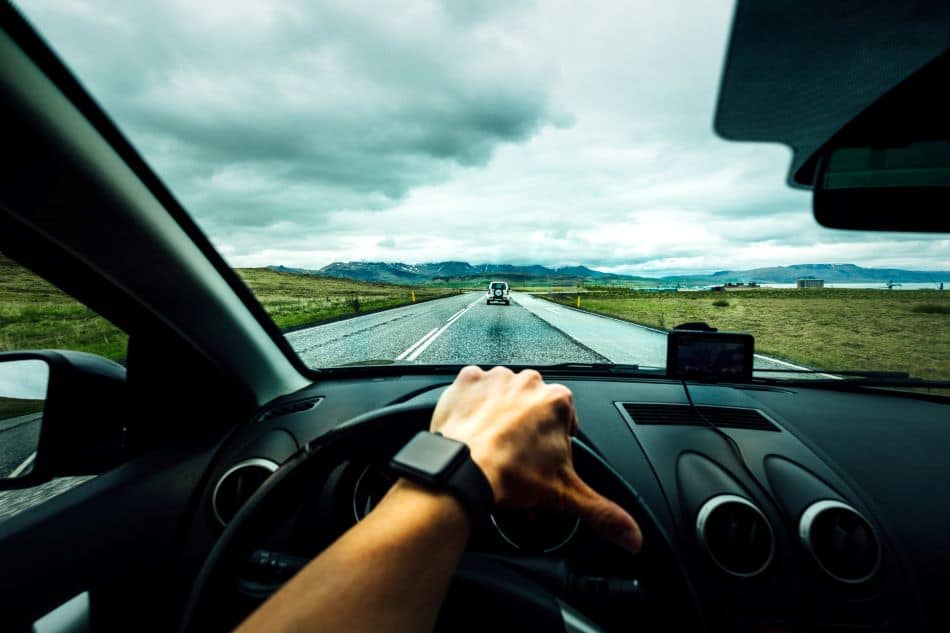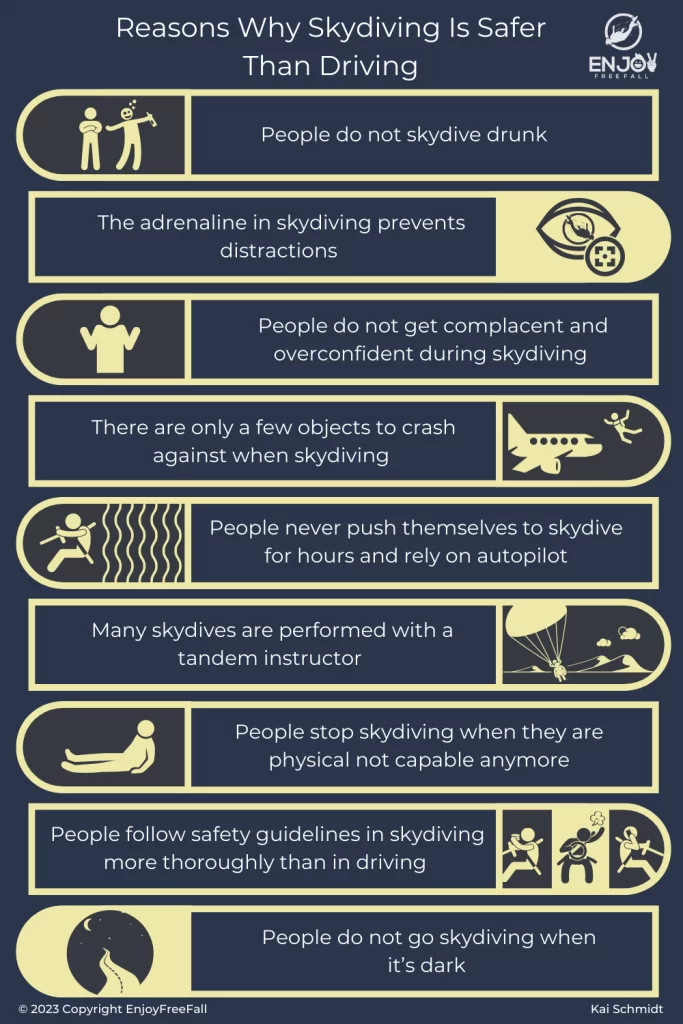
Are you thinking about ticking off one of the boxes on your bucket list and to go skydiving? You talk to your friends and family about it, and they are worried. You have heard that skydiving is safer than driving, but is this actually true?
Skydiving is statistically safer than driving. The likelihood to die in a skydiving accident is only 0.00045% in comparison to a likelihood of 0.012% for driving. Skydiving is therefore approximately 27 times safer than driving.
It sounds counterintuitive that jumping out of an airplane with just a parachute is safer than driving the car. However, there are nine reasons why skydiving is safer than driving.
I also summarized 5 activities that people are scared of even though they are also safer than driving. In addition, I researched 5 daily risks that are more likely to kill you than skydiving.
9 Reasons Why Skydiving Is Safer Than Driving A Car
Skydiving is one of the safest sports in the world with low injury and fatality rates. In fact, these are the nine causes that make skydiving safer than driving.
People Do Not Skydive When Being Drunk
One of the biggest causes of driving accidents is that people drive under the influence of alcohol. Alcohol impairs our physical and mental capabilities drastically. When driving drunk, people have much longer reaction times to their environment such that they are not able to avoid suddenly appearing objects. Even though the drunk driver might not even make a mistake, he will be slower in responding to other people’s mistakes.
In addition, driving when being drunk reduces concentration levels and impairs our vision. People do not even need to be that drunk to be impacted by these effects. Specifically, young people underestimate the risk of driving when they are drunk because they are overconfident in their abilities and believe that their abilities are not impaired.
In contrast, people do not go skydiving when being drunk. People will always make sure that they are in access to their full abilities when skydiving. In fact, the adrenaline that will be released during the jump will even boost their mental and physical abilities.
If you’re curious about more physical effects of skydiving, check out my post about the 11 incredible effects of skydiving on your body. You’ll learn all about how this thrilling activity can impact your physical and mental health in surprising ways.
The Adrenaline In Skydiving Prevents Distractions
Adrenaline is issued in a so-called fight-or-flight response when our bodies perceive danger. It allows us to think faster, react more quickly and to withstand more pain. Adrenaline also supplies the muscles with extra energy such that our muscles are able to lift heavier objects than normally. All these effects prevent people from being distracted by other things. The perceived danger is so high that they are far less likely to make any mistake.
In contrast, people feel very safe and comfortable in a car. It is warm, they might listen to some music and their thoughts might wander off. Due to this, people do lose their focus on their surroundings and other cars which often results in fatal mistakes.
People might even get distracted by something that is happening at the roadside or because they look on their phones. Looking at the phones has the same effects as having 1.6 per mille and is nowadays one of the biggest reasons for car accidents.
People Do Not Become Overconfident During Skydiving
It might sound counterintuitive that skydiving is safer because the human body is exposed to more danger, however, it is true. Not only does the adrenaline level help people to react faster, but it also prevents people from becoming overconfident.
People – even regular skydivers – are always at least a little bit afraid when jumping out of an airplane. Being fearful prevents people from becoming overconfident and from trying out stupid things.
In driving specifically people become overconfident in their ability to manage speed. This holds true specifically for young drivers. It is fun to go as fast as possible with the car and to rush through circles.
Drivers might also think that they can handle it well and most of the time they will – until they have a little bit too much speed or steer a little bit too much through the circle.
There Are Only A Few Objects To Crash Against When Skydiving
Another reason why skydiving is much safer than driving is that there is much more space and much fewer objects to crash against.
The only objects that skydivers can possibly crash against are airplanes and other skydivers. Usually, the skydiving company will make sure that there is only one airplane in the air such that skydivers only need to focus on their fellow skydivers.
Although there is a lot of space, colliding with other skydivers makes up for a good share of the skydiving accidents. However, the likelihood that this happens is still extremely low because skydivers set their jumping and parachute deploying order in advance.
When driving on the street, in contrast, there are much more objects that drivers can collide with. Even if drivers avoid an object on the street, they might go off road and collide with stones, trees or buildings. Crashing against those objects is often highly impactful and only results in so little death because of the safety standards of modern cars.
People Drive For Hours and Lose Their Concentration
People are not only often overconfident with their abilities to manage speeds but also in their ability to drive long hours. Although people do not get out of breath or sweat during driving, it is physically and mentally exhausting. This exhaustion comes at the price of focus – which can be fatal.
Losing the focus is also a slow process that drivers often do not recognize which makes it even more dangerous. If a driver realizes that he is tired, he can stop and take a break. However, if he does not, he will continue driving.
Drowsy driving after long hours or during the night is as dangerous as driving under the influence of alcohol. Some studies have shown that the reaction time of sleepy people is similar to that of people with alcohol levels above 1.0 per mille.
Similar to driving, the most accidents in skydiving happen due to human error. If you are curious about how likely you will get injured during a skydive, check out my article about the true risks of skydiving. It will give you a mind-blowing, new perspective of the sport!
Many Skydives Are Performed With A Tandem Instructor
Many skydivers are performed together with a tandem instructor. Jumping tandem means that the student hangs below the tandem instructor and is tied to him.
The tandem instructor wears the parachute and will manage the complete flight. Tandem instructors are extremely well trained and accidents almost never happen to them. Statistically speaking, tandem jumps are 2.5 times safer than skydiving solo jumps.
Similarly, driving would be much safer if people were driven around by chauffeurs or taxi drivers only. Obviously, because driving is so essential to everyone’s life, it would not be possible for everyone to drive around with a professional driver.
Autonomous driving will most likely have a strong safety effect, and driving might become even safer than skydiving.
If you want to learn more about tandem safety and why tandem skydiving is usually much safer than solo skydiving, I have written an article about that here.

People Stop Skydiving When They Are Physical Not Capable Anymore
We already touched upon the effect that people still drive when they are tired or drunk. Similarly, most people do not stop driving the car when they are physically not capable of doing it anymore.
This might be caused by increasing age, body injuries, or a loss of visual acuity. It might also be caused by mental deterioration in the course of depression and stress. Their reduced abilities make them a worse driver and therefore increase the likelihood of accidents for them and others.
In contrast, people usually stop skydiving once they are not physically and mentally capable of doing it anymore. It would be too risky otherwise. If you have this kind of filter effect, it is logical that fewer human errors are made.
People can still go skydiving even if they are old. The world record is held by a 102-year-old woman. However, people would do a tandem jump such that they do not need to manage the flight.
If a 102-year old can go skydiving, surely you can do the same! Before signing up for a tandem jump, make sure to check my extensive guide on the legal and physical skydiving requirements. It covers everything you need to know to decide if you are suitable for a skydive.
People Do Not Follow Safety Rules
Another reason why skydiving is safer than driving is that people rigorously follow safety rules. Driving and skydiving are both activities that are heavily regulated by the national authorities.
Over the past decades, companies and researchers have spent hundreds of thousands of hours to engineer equipment and cars that are as safe as possible. A lot of brainpower has also been put into designing easy and safe rules that everyone can follow.
However, people often forget about some rules in driving. Seatbelts have helped to reduce fatalities in car accidents tremendously and yet people forget to put them on (including me).
When jumping out of the airplane, in contrast, you will make sure that you follow all rules and have your equipment in place. Because skydiving is not as usual as driving and because the danger is much more feasible, people follow the instructions properly.
One of these safety rules is the minimum altitude to open a parachute. Only a few athletes have attempted to go below the recommended height. If you want to know more, feel free to read my article “minimum altitude to open a parachute”. It also includes the world’s records!
People Do Not Go Skydiving When It’s Dark
Most of the car accidents happen when it’s dark. This is partly due because people are more tired and are more likely to be drunk during the night. However, another reason is that – although lights have improved dramatically – the vision is impaired.
It is much harder to see objects, to estimate their speed, and to react to it. In the countryside, it is also more likely to drive over wild animals.
Skydiving, in contrast, is an activity for daylight and not for the night. It is only common for the military to jump during the night and it is much harder to do so. Not only is it harder to orientate yourself, but it is also harder to land safely because you do not see if there are any objects.
Were you aware that in skydiving, the landing phase is considered the most hazardous, especially during nighttime? If you’re keen to learn essential landing techniques, I’ve composed articles on both tandem and solo skydiving landings. These comprehensive guides will ensure you are thoroughly prepared for your next landing experience.
Why People Are More Scared Of Skydiving Than Of Driving
It is totally normal that people are more scared of going skydiving than driving a car. Foremost, we are used to driving a car. We were born into a society where it is normal to drive a car, hence the risk is societal accepted.
The more people are used to a certain risk, the more normal it gets and the less is its perceived danger. If everyone does a certain activity, it is not something special and we are more comfortable doing it.
Just imagine that you had never driven a car or had never seen someone drive a car. No-one of your friends could tell you that they felt safe and comfortable during the drive. Then you would probably be scared. Or take a primeval forest inhabitant who has never seen a car – he would probably be extremely scared of driving as well.
Another reason why you are more scared of skydiving than of driving is because of the so-called availability bias. We do not hear about driving accidents that often while a skydiving accident will be all over the news (as will be a plane crash).
As a result, we tend to believe that skydiving accidents are more common than driving accidents even though nothing could be further from the truth. Driving accidents are just so common, that no-one would be interested in watching the news if the media reported about them.
If you are still afraid of skydiving, check out my article about ways to calm down before a skydive and find the courage to jump.
Five Activities That You Didn’t Know Were Safer Than Driving
We do not only overestimate the risk of skydiving but also those of many other activities. To put that into perspective I have researched five risks that we perceive as being greater than driving even though they are not.
Riding a rollercoaster – People are often scared of riding a rollercoaster. Our body is exposed to strong speed accelerations, breaks, and turns. This does not only make us feel like throwing up but can be scary to do or to watch. Everyone has also seen a video of a roller coaster accident that stuck to our minds. However, statistically, roller coasters are much safer than driving.
Taking the elevator – When we take an elevator, we stop being in control of our environment. If anything happens to the elevator, we are not able to stop it. If it falls, we will fall with it. This imagination together with the feeling of being trapped can fill people with fears. Several adventure/ survival movies also helped to fuel these fears.
Rock climbing – Rock climbing is another adrenaline pumping exercise that takes a lot of courage to perform. Being only five meters above the ground with only a robe to hold oneself is scary – not to speak of 20 meters. If you climb upwards, the thoughts will strike your mind about what happens if you slip and the security robes do not hold you.
Skiing and snowboarding – Nothing represents the positive effects of adrenaline and feasible danger as good as skiing and snowboarding. In my opinion, it should be definitely more dangerous to ski than to drive a car.If you ski downhill, you can get as fast as 90 mph (150 km/h) and you do not wear much protection besides your helmet.
Car accidents with 90 mph can be deadly but most of the time you are protected by a car. However, because people perceive the danger when skiing they are less likely to make any mistakes and the snow will absorb a lot of the impact when crashing.
Dying in an airplane crash – Not only is it far less likely to die in an airplane crash, airplanes are the safest means of transportation out there. We perceive flights as more dangerous because of the availability bias. We also feel quite helpless during a flight because there is little we can do when it crashes.
Five Daily Activities That Are More Likely To Kill You Than Skydiving
It often helps to put risks into perspective in order to evaluate if it is worth taking it. To help you, I have summarized five daily activities that are riskier than skydiving below:
- It is more likely that people die from the sting of bees, wasps or hornets
- More people are killed by falling furniture
- More people slip and die during dancing
- You are more likely to die when riding your bike
- In the US, more people die from being attacked by a dog
As you can see, skydiving is safer than driving a car and than many other daily activities. I hope this article helped you overcome your fears and that it motivated you to book your skydive soon.
Enjoy your freefall soon!
P.S. Skydiving is not only extremely safe but also offers great benefits to your body and mind. If you are interested in knowing more about the nine advantages of skydiving check out this article.




